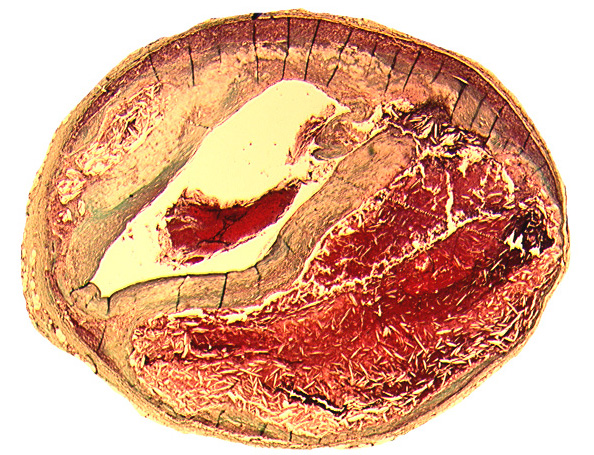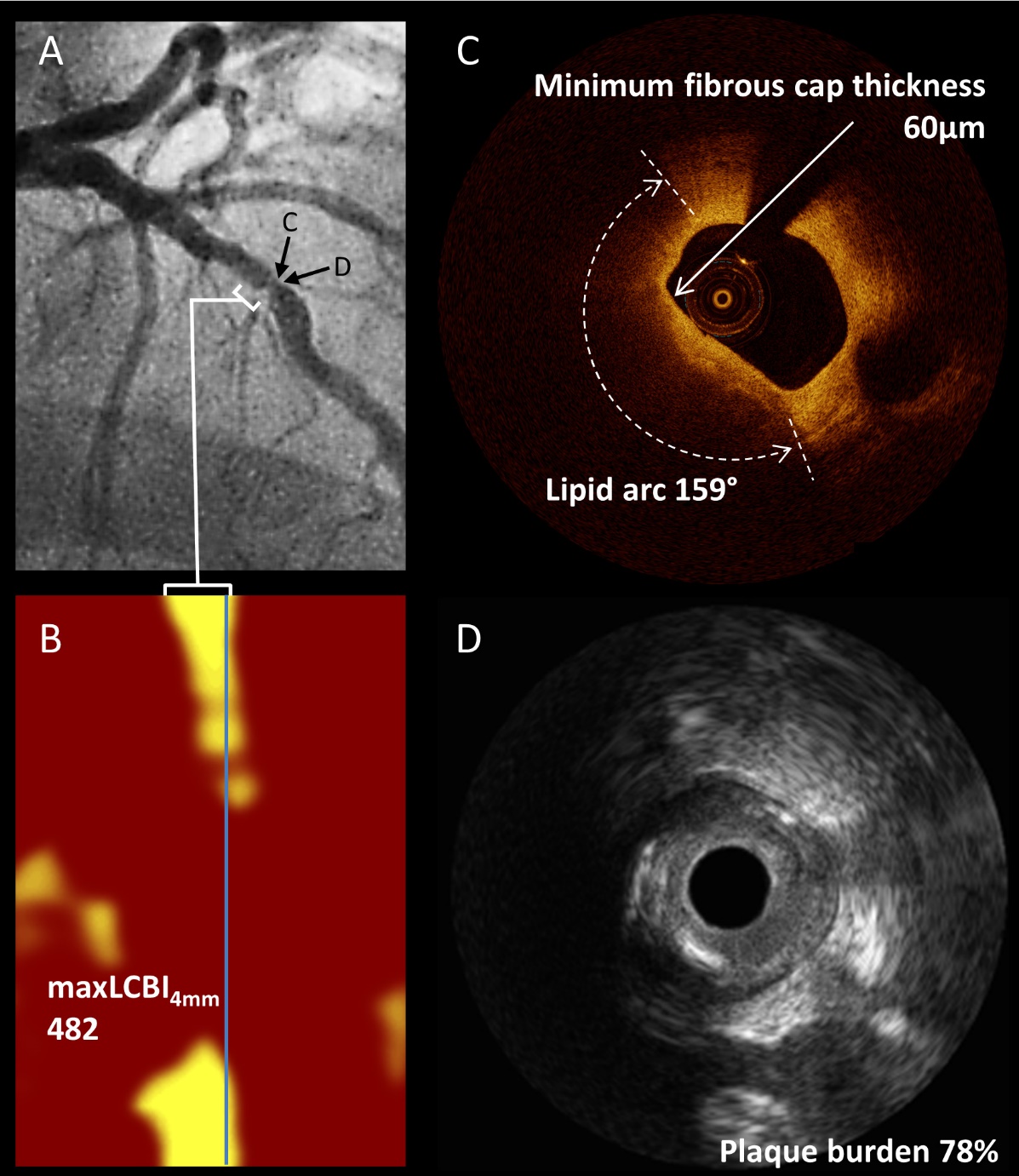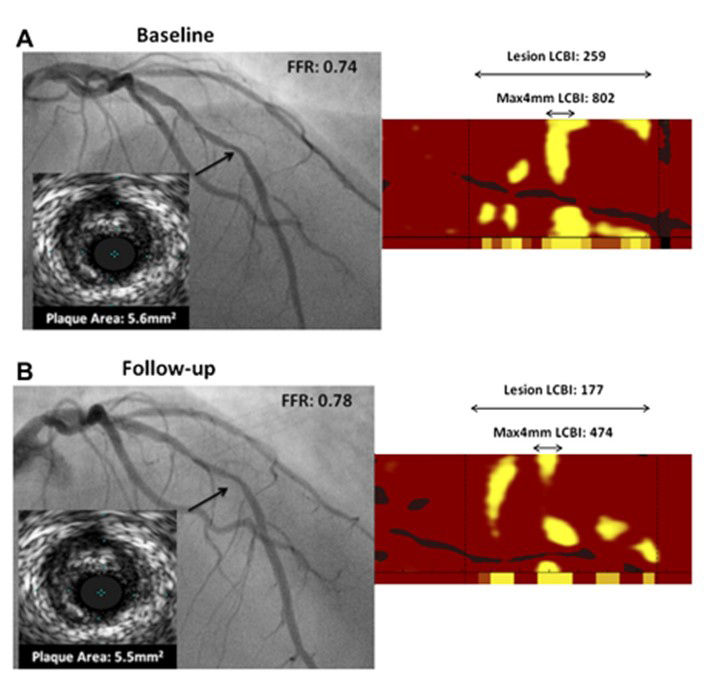Impact of Coronary Plaque Morphology on Prognosis of Patients With Chronic CAD
Introduction
The catastrophic events of death, stroke, and myocardial infarction (MI) in patients with chronic stable angina (CSA) can reach up to 20% in 5 years. Despite this evidence, CSA is routinely treated symptomatically, calling for special attention only when deterioration of symptoms affect quality of life. This conservative mentality is supported by studies showing no significant differences in outcomes when the disease is aggressively treated with percutaneous or surgical revascularization versus when it is treated with optimal medical therapy. However, the high five-year incidence of acute coronary syndrome (ACS) in this population underscores the urgent need for innovative thinking to properly identify the very-high-risk patients, tailor and apply aggressive therapy, and reduce events.
Our understanding regarding risk stratification in patients with CSA is based on three components: 1) amount of myocardium at risk, also known as ischemic burden; 2) localization and extent of coronary disease or anatomical burden; and 3) plaque composition. A recent excellent review1 addressed the first two components. This manuscript will focus in the third.
Plaque Composition
Coronary thrombosis complicating large, positively remodeled, lipid-rich, thin-capped fibroatheromas are responsible for most episodes of ACS in patients with CSA. On autopsy, thrombotic lesions are composed of a thin fibrous cap overlying a large necrotic core with active macrophage infiltration, as shown in Figure 1. Opposite to this, fibrotic lesions are usually deprived from lipid and inflammatory cells and therefore are less likely to rupture and generate thrombosis. However, fibrotic lesions can limit coronary flow and trigger exercise-induced ischemia with or without symptoms. Therefore, depending on plaque composition, coronary artery disease may predispose to ACS or to angina requiring coronary revascularization. Nevertheless, functional, noninvasive testing, angiography, and more invasive techniques including fractional flow reserve (FFR) cannot differentiate between thin-capped fibroatheromas and fibrotic lesions. On the other hand, intracoronary imaging readily characterizes plaque composition, differentiating thin-capped fibroatheromas from fibrotic lesions. As such, intracoronary imaging may offer a novel pathway to improve risk stratification beyond coronary angiography and/or FFR.2
Figure 1
Plaque Composition and Acute Coronary Events
The understanding the sudden transition from CSA to ACS relied mostly on pathologic studies for decades. Plaque rupture, plaque erosion, and calcific nodule are now widely accepted as "thrombus-prone" lesions. To apply these concepts prospectively, several studies evaluating intracoronary features of plaque vulnerability as predictors for future events were performed. The first study, known as the PROSPECT (Providing Regional Observations to Study Predictors of Events in the Coronary Tree) trial, based its observations mostly on intravascular ultrasound (IVUS) or IVUS-derived virtual histology. Major adverse cardiac events (MACE) originating from de novo lesions were up to 12.6% at 3.4 years.3 Thin-capped fibroatheroma morphology was an independent predictor of MACE, along with plaque burden >70% and minimal luminal area ≤4mm2. The synergistic effect of these three parameters increased the event rate to 18% at 3.4 years. However, this high-risk, thin-capped fibroatheromas is present in only 4.2% of all plaques studied. The second and third studies, VIVA (VH-IVUS in Vulnerable Atherosclerosis) and PREDICTION (Prediction of Progression of Coronary Artery Disease and Clinical Outcome Using Vascular Profiling of Shear Stress and Wall Morphology), also identified plaque burden >70% as a powerful independent predictor for future MACE.4,5 Other studies using near-infrared (NIR) spectroscopy also identified the size of the lipid core as a marker for future coronary events.6
In addition to thin-capped fibroatheromas, plaque erosion and calcific nodule can also lead to coronary thrombosis. Eroded plaques are characterized by a thick, smooth-muscle-cell-rich fibrous cap, reduced necrotic core areas, and neutral or negative remodeling. Plaque erosion is found in 35-40% of cases, predominately in premenopausal female smokers. Combining plaque composition and cigarette smoking suggests a systemic, prothrombogenic pathway rather than a local, atherothrombotic mechanism in plaque erosion. Regarding calcific nodule, data suggest that it is more frequently seen in the elderly population. Although each calcific nodule is small, the nodules tend to cluster, appearing as a mixture of calcified plate, bony spicules, and interspersed fibrin. These nodules have the greatest amount of calcification relative to plaque area among thrombus-prone plaques and may be associated with a healed fibroatheroma and intraplaque hemorrhage. Prospective data on calcific nodes are controversial. In fact, the incidence of MACE after 3 years in patients with nonculprit calcific nodules was better when compared with patients without calcific nodules (14.2% vs. 7.1%; p = 0.016).7
Plaque Composition and Coronary Revascularization
The most relevant contribution of plaque composition in the setting of percutaneous coronary intervention (PCI) for patients with CSA relies on predicting peri-procedural MI. Although IVUS, NIR spectroscopy, and optical coherence tomography (OCT) can independently identify patients at risk for peri-procedural MI, the combination of these three techniques offers the best prediction model, as shown in Figure 2. The multi-imaging modality study by Kini et al.8 identified three features of plaque composition associated with peri-procedural MI in patients with CSA, including 1) large plaque burden by IVUS (84% vs. 77%; p < 0.01); 2) thin fibrous cap by OCT (50 µm vs. 90 µm; p < 0.01); and 3) large lipid core burden index by NIR spectroscopy (556 vs. 339; p < 0.01). The hypothesis that plaques with a large lipid core burden index may lead to peri-procedural MI was then evaluated prospectively by Stone et al. in the CANARY (Coronary Assessment by Near-infrared of Atherosclerotic Rupture-prone Yellow) trial. Plaques with large lipid core burden index by NIR spectroscopy developed peri-procedural MI in 24.7% of patients after PCI.9 These studies clearly indicate that plaque composition can risk-stratify patients for peri-procedural MI. Therefore, these lesions may benefit from a different approach, including aggressive statin therapy, with the intent to reduce peri-procedural MI or even achieve plaque regression.
Figure 2
Plaque Composition and Coronary Plaque Regression
Several IVUS studies have shown a small but consistent reduction in atheroma volume after aggressive statin therapy. However, before reducing its volume, coronary atheroma may change plaque composition. Resolution of inflammation will reduce lipid content and increase fibrous cap thickness, leading to a more stable plaque. This change in plaque composition may be responsible for the significant reduction in future coronary events observed in patients with aggressive statin therapy. Despite the small reduction on percent atheroma volume, changing thin-capped fibroatheromas to a more fibrotic and stable plaque will reduce plaque rupture and thrombosis. To understand changes in plaque composition, the YELLOW (Reduction in Yellow Plaque by Aggressive Lipid Lowering Therapy) trial randomized patients with CSA to high-dose (40 mg) rosuvastatin versus standard statin therapy. After successful PCI of the culprit lesion, the remaining obstructive, FFR-positive, nonculprit lesion was evaluated by IVUS and NIR spectroscopy. The primary objective was reduction in lipid content. The study was not powered for clinical events. After 7 weeks of therapy, lesions randomized to the intensive group showed a significant reduction in lipid content,9 as shown in Figure 3. Importantly, all of the highest-risk lesions (plaque burden >70% and lipid core burden index >500) showed significant lipid core reduction after therapy.10 On the contrary, no change was observed in lipid core burden index by either therapy if the plaque was fibrous at baseline. In addition to lipid content reduction, significant improvement in fibrous cap thickness is almost always achieved, as documented in multiple studies using OCT.11
Figure 3
Conclusion
Despite current risk stratification and therapy, the 5-year incidence of ACS is up to 20% in patients with CSA. These acute events evolve from lipid-rich, thin-cap fibroatheromas. Therefore, risk stratification by plaque composition may improve early detection and therapy. This concept is evolving for nonobstructive disease, and more research is needed. For obstructive disease, however, imaging can predict lesions responsible for peri-procedural MI. In addition, these lipid-rich lesions associated with spontaneous rupture (ACS) or peri-procedural MI are very responsive to medical therapy. Large lipid cores can regress rapidly, and thin fibrous caps can strengthen with aggressive statin therapy.
References
- Mancini J. Angina and ischemia as predictors of outcomes in chronic coronary artery disease (ACC website). 2016. Available at: acc.org/latest-in-cardiology/articles/2016/02/02/08/21/angina-and-ischemia-as-predictors-of-outcomes-in-chronic-coronary-artery-disease. Accessed 02/13/2016.
- Moreno PR, Narula J. Thinking outside the lumen: fractional flow reserve versus intravascular imaging for major adverse cardiac event prediction. J Am Coll Cardiol 2014;63:1141-4.
- Stone GW, Maehara A, Lansky AJ, et al. A prospective natural-history study of coronary atherosclerosis. N Engl J Med 2011;364:226-35.
- Calvert PA, Obaid DR, O'Sullivan M, et al. Association between IVUS findings and adverse outcomes in patients with coronary artery disease: the VIVA (VH-IVUS in Vulnerable Atherosclerosis) Study. JACC Cardiovasc Imaging 2011;4:894-901.
- Stone PH, Saito S, Takahashi S, et al. Prediction of progression of coronary artery disease and clinical outcomes using vascular profiling of endothelial shear stress and arterial plaque characteristics: the PREDICTION Study. Circulation 2012;126:172-81.
- Oemrawsingh RM, Cheng JM, García-García HM, et al. Near-infrared spectroscopy predicts cardiovascular outcome in patients with coronary artery disease. J Am Coll Cardiol 2014;64:2510-8.
- Xu Y, Mintz GS, Tam A, et al. Prevalence, distribution, predictors, and outcomes of patients with calcified nodules in native coronary arteries: a 3-vessel intravascular ultrasound analysis from Providing Regional Observations to Study Predictors of Events in the Coronary Tree (PROSPECT). Circulation 2012;126:537-45.
- Kini AS, Motoyama S, Vengrenyuk Y, et al. Multimodality Intravascular Imaging to Predict Periprocedural Myocardial Infarction During Percutaneous Coronary Intervention. JACC Cardiovasc Interv 2015;8:937-45.
- Kini AS, Baber U, Kovacic JC, et al. Changes in plaque lipid content after short-term intensive versus standard statin therapy: the YELLOW trial (reduction in yellow plaque by aggressive lipid-lowering therapy). J Am Coll Cardiol 2013;62:21-9.
- Dohi T, Maehara A, Moreno PR, et al. The relationship among extent of lipid-rich plaque, lesion characteristics, and plaque progression/regression in patients with coronary artery disease: a serial near-infrared spectroscopy and intravascular ultrasound study. Eur Heart J Cardiovasc Imaging 2015;16:81-7.
- Moreno PR. Strengthening the Achilles heel of high-risk plaques. J Am Coll Cardiol 2014;64:2218-21.
Keywords: Acute Coronary Syndrome, Aged, Angina, Stable, Arteries, Atherosclerosis, Autopsy, Constriction, Pathologic, Coronary Angiography, Coronary Artery Disease, Coronary Thrombosis, Fibrin, Inflammation, Lipids, Macrophages, Myocardial Infarction, Myocardium, Percutaneous Coronary Intervention, Plaque, Atherosclerotic, Prospective Studies, Quality of Life, Rupture, Spontaneous, Smoking, Spectroscopy, Near-Infrared, Stroke, Tomography, Optical Coherence
< Back to Listings



